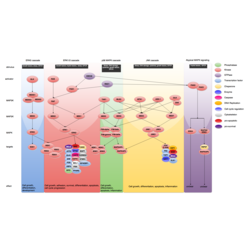MAPK Signaling
Phosphorylation is the reversible process of attaching a phosphate group to a specific amino-acid residue on a protein. Functionally, phosphorylation acts as a simple molecular switch that can activate, deactivate, or modulate the function of a protein. Addition and removal of phosphate groups provide spatial and temporal control over protein activity. Phosphorylation is tightly controlled by a competing interdependent network of kinases - which donate phosphate groups to a substrate protein, and phosphorylases - which remove them from a substrate.
Mitogen-activated protein kinases (MAPKs) are a highly conserved and ubiquitously expressed family of enzymatic kinases that phosphorylate many different target substrates. MAP-kinases are part of a larger, tiered phosphorylation cascade that includes MAP2Ks and MAP3Ks. This tiered organization affords flexibility, allowing a broad range of higher-order kinases to respond to stimuli and control cellular function through activation of a smaller subset of MAP-kinases that interact directly with other functional proteins. MAP-kinases play a major role in nearly every cellular process. MAPK dependent phosphorylation is implicated in signaling cascades that regulate cell-cycle progression, differentiation, development, and apoptosis.
References:
- : "Mitogen-activated protein (MAP) kinase pathways: regulation and physiological functions." in: Endocrine reviews, Vol. 22, Issue 2, pp. 153-83, (2001) (PubMed).





